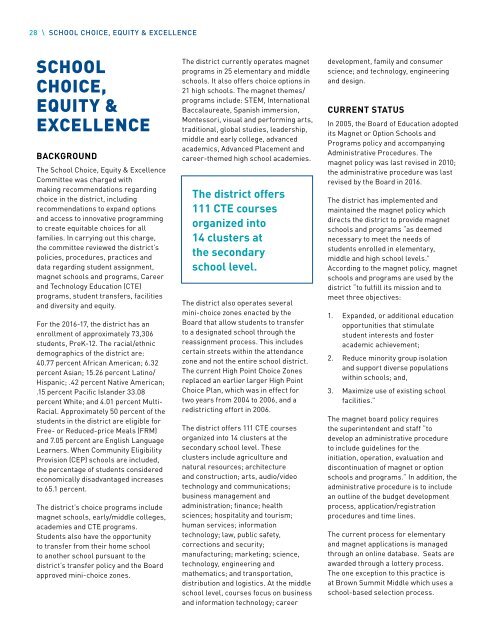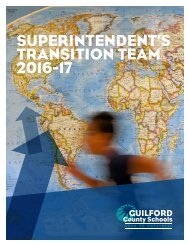Transition Team 2016-17 Final Report
You also want an ePaper? Increase the reach of your titles
YUMPU automatically turns print PDFs into web optimized ePapers that Google loves.
28 \ SCHOOL CHOICE, EQUITY & EXCELLENCE<br />
SCHOOL<br />
CHOICE,<br />
EQUITY &<br />
EXCELLENCE<br />
BACKGROUND<br />
The School Choice, Equity & Excellence<br />
Committee was charged with<br />
making recommendations regarding<br />
choice in the district, including<br />
recommendations to expand options<br />
and access to innovative programming<br />
to create equitable choices for all<br />
families. In carrying out this charge,<br />
the committee reviewed the district’s<br />
policies, procedures, practices and<br />
data regarding student assignment,<br />
magnet schools and programs, Career<br />
and Technology Education (CTE)<br />
programs, student transfers, facilities<br />
and diversity and equity.<br />
For the <strong>2016</strong>-<strong>17</strong>, the district has an<br />
enrollment of approximately 73,306<br />
students, PreK-12. The racial/ethnic<br />
demographics of the district are:<br />
40.77 percent African American; 6.32<br />
percent Asian; 15.26 percent Latino/<br />
Hispanic; .42 percent Native American;<br />
.15 percent Pacific Islander 33.08<br />
percent White; and 4.01 percent Multi-<br />
Racial. Approximately 50 percent of the<br />
students in the district are eligible for<br />
Free- or Reduced-price Meals (FRM)<br />
and 7.05 percent are English Language<br />
Learners. When Community Eligibility<br />
Provision (CEP) schools are included,<br />
the percentage of students considered<br />
economically disadvantaged increases<br />
to 65.1 percent.<br />
The district’s choice programs include<br />
magnet schools, early/middle colleges,<br />
academies and CTE programs.<br />
Students also have the opportunity<br />
to transfer from their home school<br />
to another school pursuant to the<br />
district’s transfer policy and the Board<br />
approved mini-choice zones.<br />
The district currently operates magnet<br />
programs in 25 elementary and middle<br />
schools. It also offers choice options in<br />
21 high schools. The magnet themes/<br />
programs include: STEM, International<br />
Baccalaureate, Spanish immersion,<br />
Montessori, visual and performing arts,<br />
traditional, global studies, leadership,<br />
middle and early college, advanced<br />
academics, Advanced Placement and<br />
career-themed high school academies.<br />
The district offers<br />
111 CTE courses<br />
organized into<br />
14 clusters at<br />
the secondary<br />
school level.<br />
The district also operates several<br />
mini-choice zones enacted by the<br />
Board that allow students to transfer<br />
to a designated school through the<br />
reassignment process. This includes<br />
certain streets within the attendance<br />
zone and not the entire school district.<br />
The current High Point Choice Zones<br />
replaced an earlier larger High Point<br />
Choice Plan, which was in effect for<br />
two years from 2004 to 2006, and a<br />
redistricting effort in 2006.<br />
The district offers 111 CTE courses<br />
organized into 14 clusters at the<br />
secondary school level. These<br />
clusters include agriculture and<br />
natural resources; architecture<br />
and construction; arts, audio/video<br />
technology and communications;<br />
business management and<br />
administration; finance; health<br />
sciences; hospitality and tourism;<br />
human services; information<br />
technology; law, public safety,<br />
corrections and security;<br />
manufacturing; marketing; science,<br />
technology, engineering and<br />
mathematics; and transportation,<br />
distribution and logistics. At the middle<br />
school level, courses focus on business<br />
and information technology; career<br />
development, family and consumer<br />
science; and technology, engineering<br />
and design.<br />
CURRENT STATUS<br />
In 2005, the Board of Education adopted<br />
its Magnet or Option Schools and<br />
Programs policy and accompanying<br />
Administrative Procedures. The<br />
magnet policy was last revised in 2010;<br />
the administrative procedure was last<br />
revised by the Board in <strong>2016</strong>.<br />
The district has implemented and<br />
maintained the magnet policy which<br />
directs the district to provide magnet<br />
schools and programs “as deemed<br />
necessary to meet the needs of<br />
students enrolled in elementary,<br />
middle and high school levels.”<br />
According to the magnet policy, magnet<br />
schools and programs are used by the<br />
district “to fulfill its mission and to<br />
meet three objectives:<br />
1. Expanded, or additional education<br />
opportunities that stimulate<br />
student interests and foster<br />
academic achievement;<br />
2. Reduce minority group isolation<br />
and support diverse populations<br />
within schools; and,<br />
3. Maximize use of existing school<br />
facilities.”<br />
The magnet board policy requires<br />
the superintendent and staff “to<br />
develop an administrative procedure<br />
to include guidelines for the<br />
initiation, operation, evaluation and<br />
discontinuation of magnet or option<br />
schools and programs.” In addition, the<br />
administrative procedure is to include<br />
an outline of the budget development<br />
process, application/registration<br />
procedures and time lines.<br />
The current process for elementary<br />
and magnet applications is managed<br />
through an online database. Seats are<br />
awarded through a lottery process.<br />
The one exception to this practice is<br />
at Brown Summit Middle which uses a<br />
school-based selection process.



